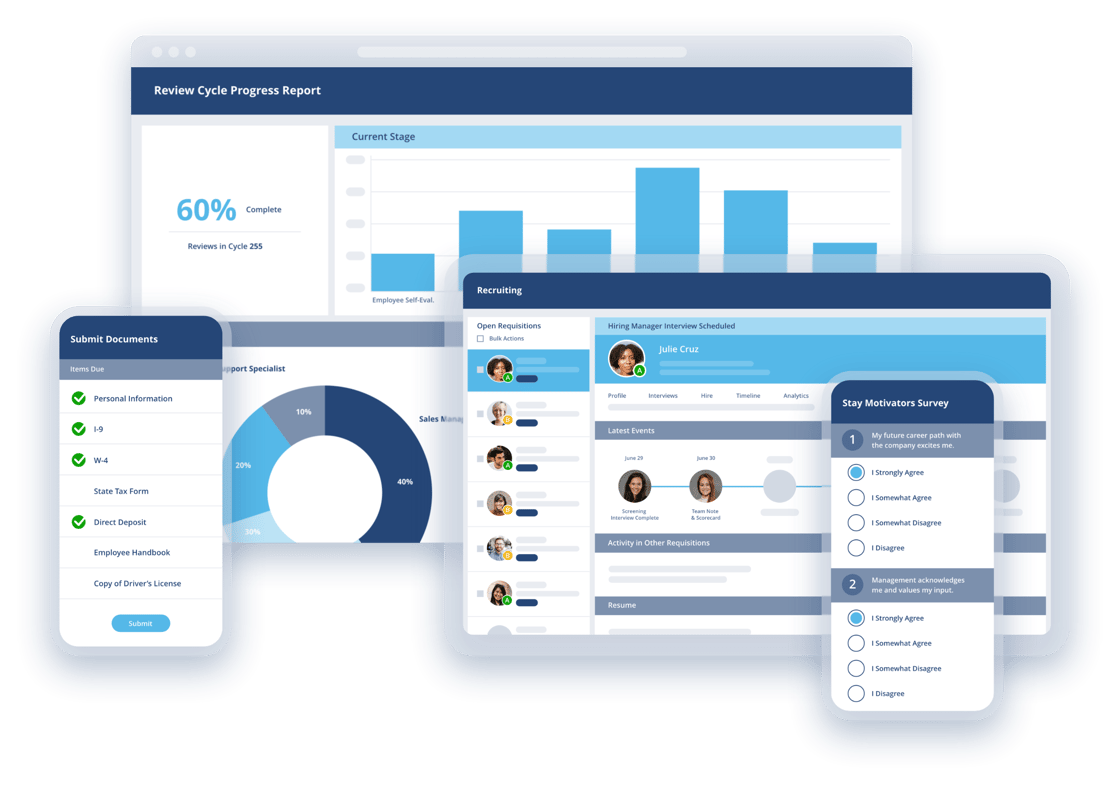This article on the four pillars of a successful performance management plan was originally published in October 2020 and updated in June 2022 to include new information and updated statistics.
It’s never a bad time to learn more about the best methods for managing employee performance. In fact, right now is an especially good time to reexamine performance management strategies: 85% of employees say they’d consider quitting if they felt their performance review was unfair. With the ongoing Great Resignation, you want to ensure your process is supportive, fair, and motivating.
So, where do you start? Begin by understanding the most important pillars of a performance management plan. From setting goals to giving feedback to learning from employee data, you can create a successful strategy when you begin with these four pillars of performance management:
- Built to incorporate company values
- Includes performance progress tracking
- Incorporates one-on-one feedback
- Uses data for continuous improvement
Keep reading to find out why these four components are an essential part of an effective performance management process.
Right now is an especially good time to reexamine performance management strategies as 85% of employees say they’d consider quitting if they felt their performance review was unfair. Find out more via @ClearCompany:Great Performance Management Embodies Company Values
TIP:
The pandemic and its continued effects bumped alignment with company values to the top of many employees’ priority lists. If your organization hasn’t yet done so, Harvard Business Review suggests asking “what’s changed?” with your company’s mission, vision, and values since March 2020. Refresh — or recommit — to your organization’s purpose, objectives, and guiding principles to build a strong performance appraisal process.
It’s an undeniable fact that employees care about their employer’s values more so now than ever. 61% of employees, especially younger workers, now say they choose their employer based on their values and beliefs. You can reinforce your company’s commitment to its values by building them into an employee performance management strategy.
For example, if your organization’s core values include continuous learning, there are many ways performance management can demonstrate that value:
- Give employees access to training and growth opportunities
- Coach managers on how to create both performance improvement plans and employee development plans
- Collaborate with employees to set individual goals for professional development regularly
- Check in with employees during training programs and certification courses to monitor effectiveness and progress
- Train managers on how to give actionable, constructive feedback
Great Performance Management Tracks Employee Progress
TIP:
Invest in a performance management system to help monitor employee performance, give regular reviews, and analyze your team’s progress with goal tracking and performance review data.
A crucial part of performance management is accurately tracking employee progression. Otherwise, how will you know when employees are improving quickly or getting off track? With a system or process for tracking growth, you gain insight into who is propelling your team forward and who needs more coaching.
Tracking employee key performance indicators also helps create more effective managers. They have more opportunities to provide their reports with actionable, relevant feedback at the right time, which 96% of employees agree is a good thing. Managers can motivate employees with useful feedback that actually helps them improve as they work toward their goals.
Great Performance Management Thrives on Face-to-Face Meetings
TIP:
HR leaders agree that the feedback employees receive during their formal performance reviews shouldn’t come as a surprise. Rather, performance conversations should be discussions about challenges, successes, and how to move forward. Keep employees in the loop and enable constant improvement by giving continuous feedback throughout review cycles.
While we’re on the subject of the importance of employee feedback, we can’t forget best practices for how to deliver feedback and conduct the performance review process. While many companies use software tools to record performance feedback and guide conversations, the process should also include a face-to-face meeting. Even if your workers are remote — and in spite of Zoom fatigue — HBR recommends video calls for performance conversations.
Talking face-to-face, even via video chat, is “more personal and humane” and allows managers to read and respond to body language. It’s also more direct, eliminating any confusion that might arise when giving constructive feedback via phone or email.
Balance digital feedback with video or in-person feedback, and make sure managers and others providing feedback understand when to use each channel. For example, they might point out a minor error or give a quick shout-out via the performance management platform. But if employees need more guidance on a project or have signed their biggest contract yet, a face-to-face conversation is in order.
I usually like to share the written review before the meeting so that they can digest the feedback and themes. This way the conversation is focused on the areas of highest impact, clarification and discussion. This also usually allows some time at the end of the conversation for me to ask how I can better support the person and to talk about forward-looking inspiration for what’s ahead.
— Nicole Keller, YieldStreet Chief People Officer
Great Performance Management Gets Better with Data
TIP:
Share your software solution’s reporting capabilities with the entire company by incorporating performance data into employee incentives, recognition programs, and leadership presentations. For example, you could call out a high-performing department or outstanding employee in a company meeting, or scale bonuses according to performance ratings.
There’s much more to performance management than just annual reviews, and much more to an effective performance management system than just record keeping. Great performance management system software unlocks the data you need to make decisions based on facts, not guesses.
With performance management software, you get access to reports that can shed light on important performance insights:
- Performance trends across different subsets of employees, including department, role, and manager
- Identify characteristics of high-performing employees
- Pinpoint what’s driving outstanding or poor performance
- Spot issues like skewed performance ratings that may have gone unnoticed
Managing performance doesn’t have to be difficult, and there are big benefits for companies and employees, especially when your plan is built on these essential elements. Get started building — or repairing the foundation — of your performance management plan by investing in a performance management system that makes tracking progress easy and empowers your team and leaders to do their best work.
Download our Performance Management System Buyer’s Guide today to ensure you choose a system that supports the foundational pillars of performance management.


